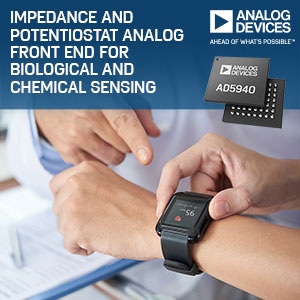Analog Devices, Inc. announced today a new electrochemical & impedance measurement front end that enables the next generation of vital sign monitoring devices and intelligent electrochemical sensors. The AD5940 analog front end incorporates both potentiostat and electrochemical impedance spectroscopy (EIS) functionality on a single chip, allowing for sensor measurement in both time and frequency domains.

The device features integrated hardware accelerators for advanced sensor diagnostics, best-in-class low noise for accurate sensor measurements and is designed for wearable “always-on” applications. Compared to traditional discrete solutions which pose limitations and require multiple ICs to achieve similar performance, ADI’s single chip solution offers advantages in terms of system accuracy and size flexibility to measure 2-Lead, 3-Lead and 4-Lead electrochemical sensors. It’s an ideal solution for applications, where high precision biological and chemical sensing is mission-critical, such as industrial gas sensing, liquid analysis, material sensing, vital signs monitoring, impedance spectroscopy and disease management.
AD5940
The AD5940 is the lowest power, highest performance Impedance and electrochemical front end with intelligent autonomous control. The analog front end combines leading levels of integration and performance for potentiostat and impedance-based electrochemical sensor managements. The on-chip potentiostat allows for a host of standard electrochemical-based measurement techniques, such as amperometric, voltametric, or impedance measurements.
The AD5940 is designed to be used in healthcare-related bio-impedance systems for both skin impedance and body impedance measurements, and also to work with the AD8233 AFE in a complete bioelectric/biopotential measurement system.
The analog front end chip can measure Voltage, current and impedance. The device consists of two potentiostat loops, a low bandwidth loop with ability to generate AC signals up to 200 Hz and a high bandwidth loop with ability to generate AC signals up to 200 kHz. The ultra-low power Potentiostat consumes 6.5 uA in biased mode.
The AD5940 measurement channel features a 16-bit, 800 kSPS, multichannel successive approximation register (SAR) analog-to-digital converter (ADC) with input buffers, a built in anti-alias filter (AAF), and a programmable gain amplifier (PGA). The ADC features an input voltage range of ±1.35 V. An input mux before the ADC allows the user to select an input channel for measurement. These input channels include multiple external current and voltage inputs, and internal voltage channels. The internal channels enable on chip diagnostic measurements of the internal supply voltages, die temperature, and reference voltages.
The AD5940 measurement blocks can be controlled via direct register writes through the Serial Peripheral Interface (SPI) interface, or alternatively, by using a pre-programmable sequencer, which provides autonomous control of the AFE chip. 6 kB of static random access memory (SRAM) is partitioned for a deep data first in, first out (FIFO) and command memory. Measurement commands are stored in the command memory and measurement results are stored in the data FIFO. A number of FIFO related interrupts are available to indicate state of the FIFO.
Pricing & Availability
| Product |
Sample Availability |
Production Availability |
Price per 1000-unit Quantity |
Package |
| AD5940 |
Now |
Released |
$4.17 |
3.6 mm × 4.2 mm, 56 ball WLCSP |